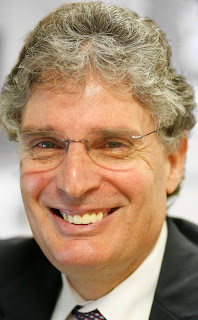Pursues Cure for Epilepsy
By Mike Lauterborn
(for June issue of
Inside Chappaqua magazine)
4/5/11
For the past 35 years, Chappaqua resident and pediatric neurologist Dr. Solomon Moshe has worked tirelessly toward finding a cure for epilepsy, a condition that affects over 50 million people worldwide. While his work at all levels has improved clinical care and an understanding of the disease, he says research will continue until such time as epileptologists are out of business.
“There are more people with epilepsy than people with cerebral palsy, Parkinson’s disease, multiple sclerosis and muscular dystrophy combined,” said Moshe, who is Vice Chairman of the Dept. of Neurology and Director of Pediatric Neurology and Clinical Neurophysiology at Montefiore Medical Center and Albert Einstein College of Medicine in the Bronx, New York. “It’s more common than autism, has many forms and can affect any age, though it’s mostly apparent in children and seniors over age 70. One in 100 people have epilepsy.”
Moshe said the condition can manifest itself in several ways. “The most common appearance is a sudden inability to communicate, but also generalized spasms and contractions,” he said. “In young children, we often see spasms, and parents think their child will die. And while more people die from epilepsy than women with breast cancer every year, less than one percent of the 50 million people with epilepsy will die annually.”
He said the common approach to the condition has been to try and prevent it from happening by using existing medications effectively. However, realizing that one-third of people with epilepsy don’t respond to medication, he and his team have developed new medications and other treatments such as surgery. They are also trying to identify beforehand those that may have the condition by doing elaborate testing, including genetic testing.
“One part of research involves developing biomarkers that can predict if seizures will be controlled or if they will be associated with other bad outcomes such as learning difficulties, autism, depression and even sudden death,” he said, “although not all people with epilepsy will exhibit these conditions.”
Moshe said they have made significant progress. “We are getting close in understanding all the crucial factors involved in the better diagnosis and treatment of all people with epilepsy,” he said.
He cited the work of several associates at Einstein. “Dr. Aristea Galanopoulou has identified new molecules that are effective in lab animal testing,” he said. “Other studies we have done uniquely involve a condition call status epilepticus, which is a very long seizure. Most often in children it’s associated with fever. Dr. Shlomo Shinnar has received government funding to identify biomarkers that will predict which children will develop epilepsy after the first bout of status epilepticus. This will lead to treatments that will influence the biomarkers early and prevent the consequences.”
Another area Moshe and his team are investigating is what makes seizures stop. “We found out that there are specific centers in the brain that can stop seizures as a function of age and gender,” he said. “This will lead to very individualized treatments.”
Moshe’s colleague Dr. Sheryl Haut is working on identifying stress factors that may precipitate a seizure in a person with epilepsy. “Once these are clearly identified, the treatment can start at the time the person first experiences the stress rather than waiting for the seizure and all the negative effects to occur,” he said.
“The last area we have pioneered is understanding the relationship between epilepsy and autism and studying the common factors that may allow the two conditions to co-exist, to design treatments that can affect both.”
Moshe said epilepsy at times can be genetic, either because there is a gene that causes the seizure or a gene that increases the susceptibility of having a seizure. “Seizure epilepsy can also happen after head trauma or a difficult birth or as a result of infections or tumors,” he added. “But even now it can be a challenge to identify a cause.”
Dr. Moshe’s peers, like Dr. Douglas Nordli, Jr., Division Head of the Epilepsy Center of the Children’s Memorial Hospital in Chicago, IL, commend him on his dedication to the cause. “He is an extraordinary individual whose research, teaching and advocacy efforts have influenced the lives of countless patients and scores of medical professionals. It is safe to say that he is the best-known and most influential pediatric epileptologist in the world.”
Moshe remains committed to the fight to eradicate and bring greater visibility to the disease. “We are trying to bring epilepsy to the forefront of awareness with government officials and public institutions so there’s better support to promote both better care and research,” he said. “As many of these patients are children and can’t speak for themselves, they need advocates. With all the emphasis and research on how the brain functions, the time is now to develop cures.”


No comments:
Post a Comment